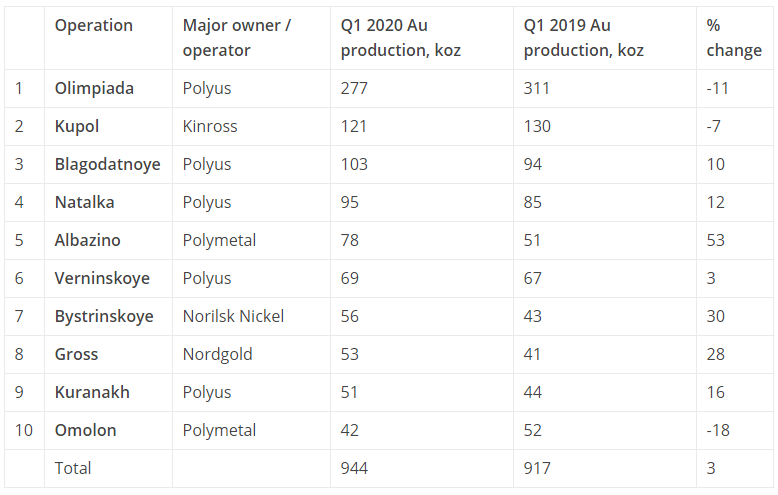
Gold production in Russia amounted to 1,246 koz in Q1 2020 and was flat y-o-y. Olimpiada was the largest gold operation in Russia in Q1 2020. Five out of the top ten largest gold mines in Russia are owned by Polyus.
Based on quarterly reported data, Mines and Metals estimated that Russia’s gold production amounted to 1,246 koz in Q1 2020 and was virtually unchanged (-1%) compared to Q1 2019 output (1,264 koz).
With 277 koz of gold mined in Q1 2020, Polyus’ gigantic Olimpiada operation was the largest gold producing center in Russia. Total gold output (refined and concentrate) declined by 11% compared to Q1 2019 (311 koz), due to changes in gold in inventory at the refinery.
Olimpiada is followed by Kinross’ Kupol mine (121 koz). 7% drop in production was mainly due to anticipated lower grades.
Polyus’ Blagodatnoye mine is third with 103 koz of gold output achieved in Q1 2020.
Fourth largest gold operation in Russia was Polyus’ Natalka mine (95 koz).
Polymetal’s Albazino mine is fifth with 78 koz of gold mined in Q1 2020. 53% production growth achieved at Albazino y-o-y has lifted this mine two positions up in the ranking.
Top 10 largest gold mines in Russia increased their output by 3% to 944 koz. Seven out of top ten mines in Russia increased their gold output in Q1 2020.
The complete list is below.
Largest gold operations in Russia: Q1 2020 Overview. Source: Mines and Metals.

1. Olimpiada. 277 koz.

Located in one of Russia’s most prolific gold mining provinces, Olimpiada is largest gold mine in Russia, one of the largest gold mines on the globe, and Polyus’ largest operation. The mine began production in 1996 and currently accounts for over a half the Moscow-based company’s total gold output. The ore mined at the site is processed at three plants with a combined capacity of 13 million tonnes of ore annually. To treat Olimpiada’s sulphide ores, Polyus employs BIONORD, the Company’s proprietary bio-oxidation technology.
2. Kupol. 121 koz.

Kupol is a high grade underground mine located in the Chukotka region of the Russian Far East. It is second largest gold mine in Russia and has one of the lowest operating costs in Kinross’ portfolio. Kupol’s consistently strong operating results make it a model for successfully operating in a remote region, with the nearest major city approximately 200 kilometres away. Supplies and equipment are transported to the mine from around mid-January to early May via a 380-kilometre winter road. Kupol’s mill was expanded in 2013 from 3,500 to 4,500 tonnes per day to process additional ore from the nearby Dvoinoye mine.
3. Blagodatnoye. 103 koz.

Located only 25 kilometres away from Polyus’ flagship operation, Olimpiada, Blagodatnoye is the Company’s second largest mine. Commissioned in July 2010, it boasts a processing capacity of 8 mln tonnes of ore per year, which makes it one of the largest ore processing plants in the Russian gold mining sector.
4. Natalka. 95 koz.

Natalka is located in the Magadan Region on the northern Pacific coast of Russia, in one of the most remote and cold parts of the country. It is a major open-pit gold deposit which was discovered in 1942. Polyus acquired Natalka in 2008. The construction of a mining complex began in 2012, and active full-scale mining was launched in early 2013. However, mining and construction works at the mill were soon halted. Construction at Natalka restarted in 2016. Mining operations were relaunched in January 2017, and hot commissioning was successfully completed at the mill. Polyus fully ramped up production at Natalka in the second half of 2018.
5. Albazino. 78 koz.

Albazino, acquired by Polymetal in 2006, is a high-grade refractory gold mine developed as a Greenfield project by Polymetal. Today, it comprises an operating open-pit mine and a 1.6 Mtpa on-site flotation concentrator that was first launched in 2011. Albazino is an integral part of the group’s largest project — the Amursk POX Hub, where Albazino gold concentrate is transported and then processed into dore bars.
Read more by Vladimir Basov







